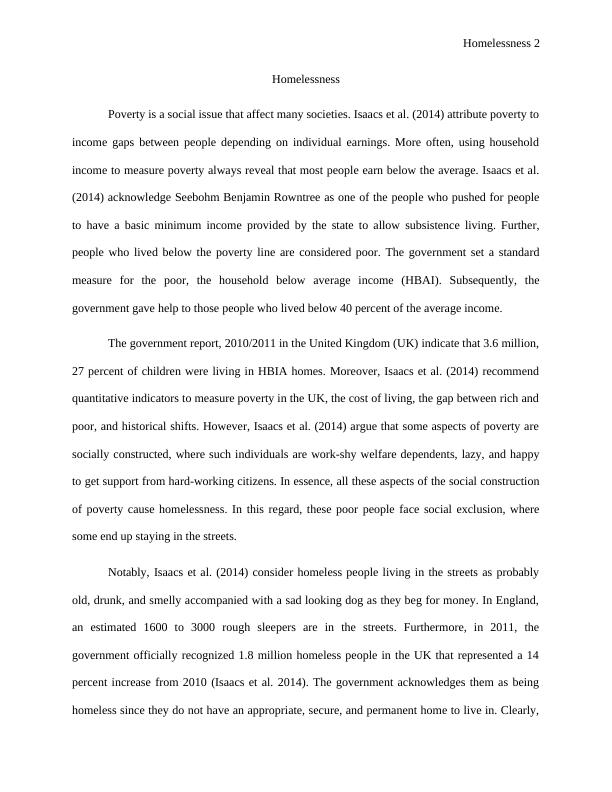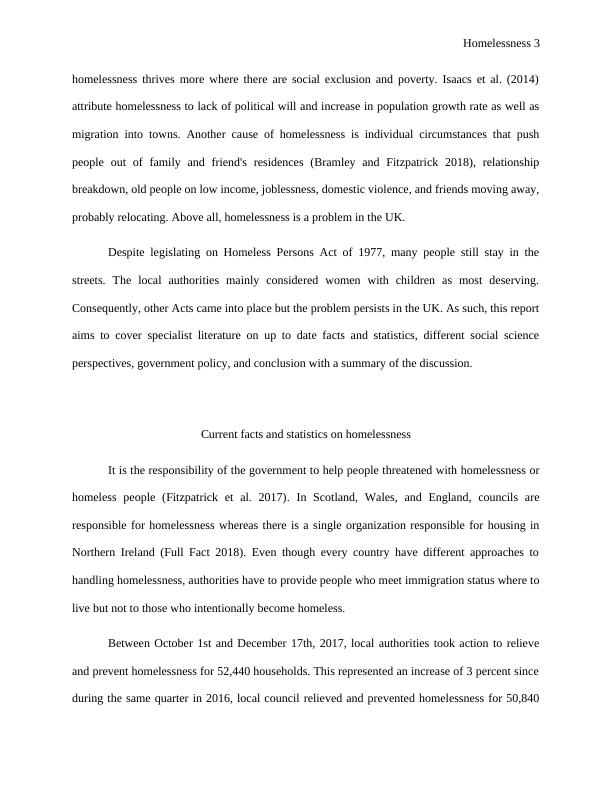Homelessness: Facts, Statistics, Types, and Government Policy
11 Pages2959 Words55 Views
Added on 2023-06-13
About This Document
This report covers specialist literature on up to date facts and statistics, different social science perspectives, government policy, and conclusion with a summary of the discussion on homelessness in the UK.
Homelessness: Facts, Statistics, Types, and Government Policy
Added on 2023-06-13
ShareRelated Documents
Homelessness 1
HOMELESSNESS
by [Name]
Course
Professor’s Name
Institution
Location of Institution
Date
HOMELESSNESS
by [Name]
Course
Professor’s Name
Institution
Location of Institution
Date

Homelessness 2
Homelessness
Poverty is a social issue that affect many societies. Isaacs et al. (2014) attribute poverty to
income gaps between people depending on individual earnings. More often, using household
income to measure poverty always reveal that most people earn below the average. Isaacs et al.
(2014) acknowledge Seebohm Benjamin Rowntree as one of the people who pushed for people
to have a basic minimum income provided by the state to allow subsistence living. Further,
people who lived below the poverty line are considered poor. The government set a standard
measure for the poor, the household below average income (HBAI). Subsequently, the
government gave help to those people who lived below 40 percent of the average income.
The government report, 2010/2011 in the United Kingdom (UK) indicate that 3.6 million,
27 percent of children were living in HBIA homes. Moreover, Isaacs et al. (2014) recommend
quantitative indicators to measure poverty in the UK, the cost of living, the gap between rich and
poor, and historical shifts. However, Isaacs et al. (2014) argue that some aspects of poverty are
socially constructed, where such individuals are work-shy welfare dependents, lazy, and happy
to get support from hard-working citizens. In essence, all these aspects of the social construction
of poverty cause homelessness. In this regard, these poor people face social exclusion, where
some end up staying in the streets.
Notably, Isaacs et al. (2014) consider homeless people living in the streets as probably
old, drunk, and smelly accompanied with a sad looking dog as they beg for money. In England,
an estimated 1600 to 3000 rough sleepers are in the streets. Furthermore, in 2011, the
government officially recognized 1.8 million homeless people in the UK that represented a 14
percent increase from 2010 (Isaacs et al. 2014). The government acknowledges them as being
homeless since they do not have an appropriate, secure, and permanent home to live in. Clearly,
Homelessness
Poverty is a social issue that affect many societies. Isaacs et al. (2014) attribute poverty to
income gaps between people depending on individual earnings. More often, using household
income to measure poverty always reveal that most people earn below the average. Isaacs et al.
(2014) acknowledge Seebohm Benjamin Rowntree as one of the people who pushed for people
to have a basic minimum income provided by the state to allow subsistence living. Further,
people who lived below the poverty line are considered poor. The government set a standard
measure for the poor, the household below average income (HBAI). Subsequently, the
government gave help to those people who lived below 40 percent of the average income.
The government report, 2010/2011 in the United Kingdom (UK) indicate that 3.6 million,
27 percent of children were living in HBIA homes. Moreover, Isaacs et al. (2014) recommend
quantitative indicators to measure poverty in the UK, the cost of living, the gap between rich and
poor, and historical shifts. However, Isaacs et al. (2014) argue that some aspects of poverty are
socially constructed, where such individuals are work-shy welfare dependents, lazy, and happy
to get support from hard-working citizens. In essence, all these aspects of the social construction
of poverty cause homelessness. In this regard, these poor people face social exclusion, where
some end up staying in the streets.
Notably, Isaacs et al. (2014) consider homeless people living in the streets as probably
old, drunk, and smelly accompanied with a sad looking dog as they beg for money. In England,
an estimated 1600 to 3000 rough sleepers are in the streets. Furthermore, in 2011, the
government officially recognized 1.8 million homeless people in the UK that represented a 14
percent increase from 2010 (Isaacs et al. 2014). The government acknowledges them as being
homeless since they do not have an appropriate, secure, and permanent home to live in. Clearly,

Homelessness 3
homelessness thrives more where there are social exclusion and poverty. Isaacs et al. (2014)
attribute homelessness to lack of political will and increase in population growth rate as well as
migration into towns. Another cause of homelessness is individual circumstances that push
people out of family and friend's residences (Bramley and Fitzpatrick 2018), relationship
breakdown, old people on low income, joblessness, domestic violence, and friends moving away,
probably relocating. Above all, homelessness is a problem in the UK.
Despite legislating on Homeless Persons Act of 1977, many people still stay in the
streets. The local authorities mainly considered women with children as most deserving.
Consequently, other Acts came into place but the problem persists in the UK. As such, this report
aims to cover specialist literature on up to date facts and statistics, different social science
perspectives, government policy, and conclusion with a summary of the discussion.
Current facts and statistics on homelessness
It is the responsibility of the government to help people threatened with homelessness or
homeless people (Fitzpatrick et al. 2017). In Scotland, Wales, and England, councils are
responsible for homelessness whereas there is a single organization responsible for housing in
Northern Ireland (Full Fact 2018). Even though every country have different approaches to
handling homelessness, authorities have to provide people who meet immigration status where to
live but not to those who intentionally become homeless.
Between October 1st and December 17th, 2017, local authorities took action to relieve
and prevent homelessness for 52,440 households. This represented an increase of 3 percent since
during the same quarter in 2016, local council relieved and prevented homelessness for 50,840
homelessness thrives more where there are social exclusion and poverty. Isaacs et al. (2014)
attribute homelessness to lack of political will and increase in population growth rate as well as
migration into towns. Another cause of homelessness is individual circumstances that push
people out of family and friend's residences (Bramley and Fitzpatrick 2018), relationship
breakdown, old people on low income, joblessness, domestic violence, and friends moving away,
probably relocating. Above all, homelessness is a problem in the UK.
Despite legislating on Homeless Persons Act of 1977, many people still stay in the
streets. The local authorities mainly considered women with children as most deserving.
Consequently, other Acts came into place but the problem persists in the UK. As such, this report
aims to cover specialist literature on up to date facts and statistics, different social science
perspectives, government policy, and conclusion with a summary of the discussion.
Current facts and statistics on homelessness
It is the responsibility of the government to help people threatened with homelessness or
homeless people (Fitzpatrick et al. 2017). In Scotland, Wales, and England, councils are
responsible for homelessness whereas there is a single organization responsible for housing in
Northern Ireland (Full Fact 2018). Even though every country have different approaches to
handling homelessness, authorities have to provide people who meet immigration status where to
live but not to those who intentionally become homeless.
Between October 1st and December 17th, 2017, local authorities took action to relieve
and prevent homelessness for 52,440 households. This represented an increase of 3 percent since
during the same quarter in 2016, local council relieved and prevented homelessness for 50,840

Homelessness 4
households. In addition, on 31st December 2017, the number of temporary accommodation rose
from 75,740 in 2016 to 78,930. The rise occasioned a 4 percent increase in 2017 (MHCLG
2018).
In England, the councils provide homeless persons who have ‘priority need' where to live
(MHCLG 2018). These groups comprise of vulnerable people for various reasons, people in
emergency after fire or flood, or families with children. Further, such people must not have
become homeless deliberately or failed to do anything that resulted in their plight. During
2016/2017, about 59,000 households got housing assistance from the council. This number has
been on the rise since 2009/2010, which represent about 50 percent rise. In another word, the
council accepted 135,000 households in 2003/2004.
Notwithstanding, Statista (2018) reports that around 20 percent of the UK households are
earning less than 299 British pounds per week. Many lead low standard of living despite the UK
being one of the most developed countries in the world. From this view, 81 percent of people
between 25 and 34 years earn their income from wages. This distribution of total gross
household income from salaries and wages indicate that when a person between 25 and 34 years
losses a job, they may probably end up homeless. Furthermore, in 2015/2016 8.1 thousand
became homeless in London. Among the reported rough sleepers, 85 percent were male. This
finding echoes Isaacs et al. (2014) sentiments that local council consider women with children as
the priority need group. Moreover, the majority of rough sleepers on the streets of London are
whites. According to ethnic distribution of rough sleepers, two-thirds are of white origin (Statista
2018). Among these people, 30 percent of them are of the age between 36 and 45 years old.
Additionally, on the streets of London, Westminster had two thousand more people sleeping on
the streets than Camden according to 2016 reports (Statista 2018).
households. In addition, on 31st December 2017, the number of temporary accommodation rose
from 75,740 in 2016 to 78,930. The rise occasioned a 4 percent increase in 2017 (MHCLG
2018).
In England, the councils provide homeless persons who have ‘priority need' where to live
(MHCLG 2018). These groups comprise of vulnerable people for various reasons, people in
emergency after fire or flood, or families with children. Further, such people must not have
become homeless deliberately or failed to do anything that resulted in their plight. During
2016/2017, about 59,000 households got housing assistance from the council. This number has
been on the rise since 2009/2010, which represent about 50 percent rise. In another word, the
council accepted 135,000 households in 2003/2004.
Notwithstanding, Statista (2018) reports that around 20 percent of the UK households are
earning less than 299 British pounds per week. Many lead low standard of living despite the UK
being one of the most developed countries in the world. From this view, 81 percent of people
between 25 and 34 years earn their income from wages. This distribution of total gross
household income from salaries and wages indicate that when a person between 25 and 34 years
losses a job, they may probably end up homeless. Furthermore, in 2015/2016 8.1 thousand
became homeless in London. Among the reported rough sleepers, 85 percent were male. This
finding echoes Isaacs et al. (2014) sentiments that local council consider women with children as
the priority need group. Moreover, the majority of rough sleepers on the streets of London are
whites. According to ethnic distribution of rough sleepers, two-thirds are of white origin (Statista
2018). Among these people, 30 percent of them are of the age between 36 and 45 years old.
Additionally, on the streets of London, Westminster had two thousand more people sleeping on
the streets than Camden according to 2016 reports (Statista 2018).

End of preview
Want to access all the pages? Upload your documents or become a member.
Related Documents
Social Problem of UK - Essaylg...
|13
|3680
|121
Causes of Youth Homelessness in Australialg...
|8
|1838
|76
Interrelationship Between Vulnerability and Social and Health Problemslg...
|12
|1590
|219
Affordable Housing Mandates in the USAlg...
|10
|2257
|246
Essay on Strategies Of Economics Developmentlg...
|11
|3685
|547
Health Inequalities Assignmentlg...
|9
|2159
|106
